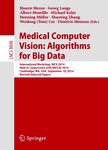版权所有:内蒙古大学图书馆 技术提供:维普资讯• 智图
内蒙古自治区呼和浩特市赛罕区大学西街235号 邮编: 010021
T=题名(书名、题名),A=作者(责任者),K=主题词,P=出版物名称,PU=出版社名称,O=机构(作者单位、学位授予单位、专利申请人),L=中图分类号,C=学科分类号,U=全部字段,Y=年(出版发行年、学位年度、标准发布年)
AND代表“并且”;OR代表“或者”;NOT代表“不包含”;(注意必须大写,运算符两边需空一格)
范例一:(K=图书馆学 OR K=情报学) AND A=范并思 AND Y=1982-2016
范例二:P=计算机应用与软件 AND (U=C++ OR U=Basic) NOT K=Visual AND Y=2011-2016
Aiming at the use of hand gestures for human-computer interaction, this paper presents an approach to identify hand gestures using muscle activity separated from electromyogram (EMG) using independent component analysis. While there are a number of previous reported works where EMG has been used to identify movement, the limitation of the earlier works is that the systems are suitable for gross actions, and when there is one prime-mover muscle involved. This paper reports overcoming the difficulty by using independent component analysis to separate muscle activity from different muscles and classified using backpropogation neural networks. The paper reports experimental results where the system was accurately able to identify the hand gesture using this technique for all the experiments (100%). The system has been shown not to be sensitive to electrode position as the experiments were repeated on different days. The advantage of such a system is that it is easy to train by a lay user, and can easily be implemented in real time after the initial training.
Multi-camera environments allow constructing volumetric models of the scene to improve the analysis performance of computer vision algorithms (e.g. disambiguating occlusion). When representing volumetric results of image-based multi-camera analysis, a direct approach is to scan the 3D space with regular voxels. Regular voxelization is good at high spatial resolutions for applications such as volume visualization and rendering of synthetic scenes generated by geometric models, or to represent data resulting from direct 3D data capture (e.g. MRI). However, regular voxelization shows a number of drawbacks for visual scene analysis, where direct measurements on 3D voxels are not usually available. In this case, voxel values are computed rather as a result of the analysis on 'projected' image data.
In this paper, we first provide some statistics to show how voxels project to 'unbalanced' sets of image data in common multi-view analysis settings. Then, we propose a 3D geometry for multi-view scene analysis providing a better balance in terms of the number of pixels used to analyse each elementary volumetric unit. The proposed geometry is non-regular in 3D space, but becomes regular once projected onto camera images, adapting the sampling to the images. The aim is to better exploit multi-view image data by balancing its usage across multiple cameras instead of focusing in regular sampling of 3D space, from which we do not have direct measurements. An efficient recursive algorithm using the proposed geometry is outlined. Experimental results reflect better balance and higher accuracy for multi-view analysis than regular voxelization with equivalent restrictions.
This paper examines the use of facial muscle activity (Surface Electromyogram) to recognise speech based commands in English and German language without any audio signals. The system is designed for applications based on speech control for human computer interaction (HCI). The paper presents an effective technique that uses the facial muscle activity of the articulatory muscles and human factors for recognition. The difference in the speed and style of speaking varies between experiments, and this variation appears to be more pronounced when people are speaking a foreign language. To overcome this difficulty, the paper reports measuring the relative activity of the articulatory muscles for recognition of unvoiced vowels of English and German languages. In these investigations, three English vowels and three German vowels were used as recognition variables. The moving root mean square (RMS) of surface electromyo-gram (SEMG) of four facial muscles is used to segment the signal and to identify thestart and end of a silently spoken utterance. The relative muscle activity is computed by integrating and normalising the RMS values of the signals between the detected start and end markers. The output vector of this is classified using a back propagation neural network to identify the voiceless speech. The data is also tested using K means clustering technique to determine the linearity of separation of the data. The experimental results show that this technique gives high recognition rate when used for each of the participants for both of the languages. The investigations also show that the system is easy to train for a new user. The visual inspection of the plot of the experimental data suggests the formation of clusters. The results suggest that such a system is reliable for simple vowel based commands for human computer interface when it is trained for the user, who can speak one or more languages and for the people who have speech disability.

电话和邮箱必须正确填写,我们会与您联系确认。
版权所有:内蒙古大学图书馆 技术提供:维普资讯• 智图
内蒙古自治区呼和浩特市赛罕区大学西街235号 邮编: 010021

暂无评论